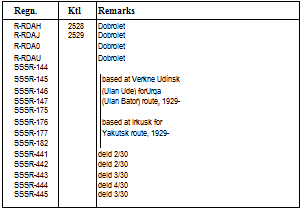The F 13 in Russia
Junkers leaped at the chance of taking advantage of the Treaty of Rapallo, signed on 16 April 1922, and in which Germany became the first country to recognize the Soviet Union. A production line was set up at Fili, a suburb of
Moscow, where a factory had been built in 1916 to produce the Il’ya Muromets. The Fili-built F 13s were designated Ju 13s.
During 1923, under the title of Junkers Luftverkehr Russians!, Ju 13s operated a trunk route from Moscow to Baku, on the Caspian Sea, and center of the new oil industry. It thus provided a westbound airlink, via Moscow, with Berlin, via Deruluft; and a potential eastbound connection to Persia — an intriguing aerial variant of the Drag Nacht Oosten movement that had, in 1889, seen the Sponsorship of the Baghdad Railway, in an effort to extend German influence in Asia.
German infiltration into Russian aviation dwindled by the mid-1920s. The Moscow — Baku route was taken over by Ukrvozdukhput (see next page). But Junkers aircraft were put to good use all over the Soviet Union (see also pages 20 and 24).
 JUNKERS-W 33 IN SOVIET SERVICE
JUNKERS-W 33 IN SOVIET SERVICE










